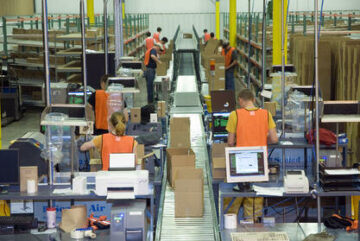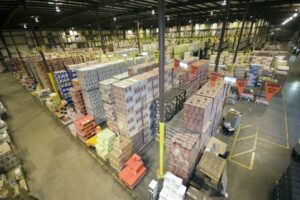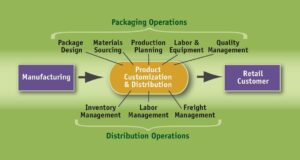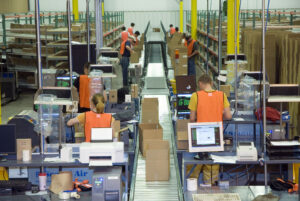Billions of dollars of product are lost each year to product and packaging damage in the grocery industry. Product damage is a particularly severe profit drain for wine and spirits manufacturers trying to keep a fragile product intact during the distribution journey from the bottling plant to the store shelf or doorstep.
A case of wine, for instance, might have a retail value of $50. If you ship 25 million cases in a year and have a damage rate of just .05%, that’s $625,000 worth of product that cannot be sold. In addition, there are labor costs involved in clean-ups and reprocessing orders that can easily add $20,000 a month to that damage number. If you bring that damage ratio down slightly to .03%, combined product and labor costs are reduced by around $325,000 – dollars that drop straight to the bottom line.
So yes, damage mitigation is a big deal for wine and spirits companies.
First, the basics
 Glass bottles of wine and liquor are heavy and breakable. That’s a bad combination if you’re a company moving tens of thousands of cases a day down highways, warehouse aisles and conveyors. If cases fall, they will break; that’s just gravity. An average small parcel shipment might weigh about 2.5 pounds. The average weight of a case of wine is 35 pounds. So personal injury can’t be ignored in this discussion. Legs and backs can be damaged too, leading to costly lost-time injuries.
Glass bottles of wine and liquor are heavy and breakable. That’s a bad combination if you’re a company moving tens of thousands of cases a day down highways, warehouse aisles and conveyors. If cases fall, they will break; that’s just gravity. An average small parcel shipment might weigh about 2.5 pounds. The average weight of a case of wine is 35 pounds. So personal injury can’t be ignored in this discussion. Legs and backs can be damaged too, leading to costly lost-time injuries.
For one wine and spirits distributor, KANE did about 30,000 case picks a day during the holiday season just passed. That’s a lot of bending and lifting. If you don’t do it right, a broken bottle could be the least of your worries.
Your choice of transportation mode will have an impact on damage rates. Rail transport can be a very economical transport mode for wine and spirits, but products are more susceptible to damage than in a truck due to poor handling, hump yards and grouping. But if you’re shipping cross-country, shipping costs will be dramatically cheaper, not to mention more carbon friendly. In this case, any added damage-related expense could be outweighed by these transportation savings.
6 damage-reducing strategies
What steps can you take to reduce your damage ratio and add hundreds of thousands of dollars to your company’s profit line? Here are six proven strategies to consider.
1. Wrap it tight
In our largest wine distribution center, we utilize 6 automatic stretch wrapping machines and productivity has soared as a result. The units wrap pallets as they sit stationary on a tray. Movement is not your friend during final delivery and tight wrapping eliminates case movement on the pallets. We purchase used wrapping machines in order to purchase extra machines so there is never an excuse not to wrap outgoing pallets.
2. Train thoroughly
KANE has a dedicated trainer who works with associates on forklift skills and overall handling of this fragile inventory. New hires start with a week-long classroom session. For forklift driving, we’ve adapted the Smith System to our requirements in the warehouse.
Drivers are taught to “aim high” in order to recognize everything going on well ahead of them and to the sides. This prevents the need for sudden stops. If you stop short while moving a pallet of cereal, no problem. But if you’re using a double forklift to move 4,000–8,000 pounds of product, that product won’t stop with you. It will keep moving forward and off the end of the fork.
Associates will vary in terms of their ability to comply and execute against SOPs. That’s why you need to constantly look at the individual performance numbers and recognize opportunities for mentoring and retraining.
3. Get the carton size right
Cases of wine and spirits are stackable, but can be crushed if packaging engineers haven’t done their jobs. The key is the “head space” between the top of the bottles and the closed box. To reduce damage, bottlers need “negative head space,” making sure the bottle top actually touches the box without pushing it up. When head space exists, it’s called a “crush zone.” The bottles inside must be kept firmly in place because movement of any kind within the box will result in damage. Sometimes, new wine producers aren’t even aware of the importance of this head space issue and must learn the hard way.
4. Use the right handling equipment
We talked about the consequences of sudden stops by a forklift driver that can cause heavy cases to shift and fall. With quick-pick trucks, the picker simply presses a button on his handheld device and the truck automatically moves to the next designated pick location. This results in less walking for the picker, but another advantage is that you can regulate the speed of these pallet trucks and program them to stop gradually.
Forklifts need the right attachments for wine distribution, like rubber clamps that squeeze pallets tight from the side. These can cost $15,000. On top of that, KANE attaches a small, aftermarket addition – a diamond plate – to the bottom of each paddle to ensure there is absolutely no movement of cases during transport in the warehouse. Unlike clamps, which apply pressure but don’t grab, the diamond plate acts like fingers, grabbing and stabilizing the pallets.
Using double forklifts is an excellent way to improve productivity in a wine and spirits distribution center. And when you reduce your touches by 50%, you also reduce opportunities for damage.
Pallet choice can also cut your damage ratio. It can be very tempting to use a cheaper grade of pallet. In fact, companies can cut pallet costs in half by switching from high-grade pallets that weigh about 74 pounds to average white wood pallets that can weigh under 20 pounds. But the lighter pallets just can’t handle the weight and wear and tear of a high-volume wine and spirits distribution operation.
5. Knowledge Sharing and Communication
Damage mitigation for any wine and spirits manufacturer or distributor is a team sport. Many people touch the product during its supply chain journey. These supply chain partners need to talk.
As the manager of a large distribution warehouse for wine, I speak regularly to the person who builds the pallets at the bottling plant 3,000 miles away. My team has an ongoing dialogue with officials at the short line that brings 17 rail box cars a day to our rail-sided facility.
When we’re one of multiple 3PLs that share responsibility for getting a customer’s products to market, KANE is sharing best practices with the broader team to drive the damage ratio down (and drive quality and productivity up).
Naturally at KANE, where we serve multiple wine and liquor customers, we’re constantly comparing notes internally and sharing new approaches to determine which should be adopted across all operations. It’s not about being a hero, it’s about collaborating and being a good teammate.
6. Hire for attitude
When do you drop things in the kitchen? Or accidentally spill your morning coffee? Or veer into the next lane on a highway – even for a split second?
When you’re distracted.
There’s no room for distraction when you’re lifting a 2,200-pound pallet of full glass bottles and loading it onto a trailer. Too many bad things can happen – to the product, to your co-workers, and to you.
At KANE, we’re big believers in the saying “hire for attitude, train for skill.” People who regularly work when they are angry or unfocused – when their mind is somewhere – can’t do this job and work safe. It’s best to find teachable, positive people to interview, hire and train.
Considering 3PL support for wine and spirits distribution?
If you are considering 3PL support for your wine and spirits distribution, remember that this product has some unique handling requirements that benefit from partnering with an experienced provider.
Anyone can say they can skateboard down a huge hill. But it’s only the experienced skateboarder who will make it to the bottom with no problems. Kane Logistics ships about 26 million cases of wine & spirits a year for its customers with over 30 years of strategic focus on wine and spirits logistics.
To learn what KANE’s wine and spirits distribution experience can do for your operation, contact us to start a conversation.
Source: https://www.kanelogistics.com/blog/wine-spirits-reduce-product-damage-warehouse
- "
- &
- 000
- ADvantage
- All
- around
- auto
- BEST
- best practices
- Box
- carbon
- cars
- cases
- Cause
- closed
- code
- Coffee
- Companies
- company
- Costs
- Customers
- day
- deal
- delivery
- DID
- dollars
- driver
- driving
- Drop
- Engineers
- Facility
- Focus
- fork
- Forward
- full
- good
- grab
- grocery
- Handling
- head
- here
- highways
- hire
- HTTPS
- HubSpot
- huge
- Hundreds
- Impact
- industry
- Interview
- inventory
- involved
- IT
- Job
- Jobs
- Key
- knowledge
- labor
- large
- leading
- LEARN
- Line
- location
- logistics
- Machines
- Making
- Manufacturer
- Market
- million
- move
- moves
- numbers
- Operations
- order
- orders
- packaging
- People
- performance
- poor
- pounds
- pressure
- Producers
- Product
- productivity
- Products
- Profit
- Program
- purchase
- quality
- Rail
- Rates
- reduce
- Requirements
- Results
- retail
- retraining
- rubber
- safe
- Share
- shift
- Shipping
- ships
- Short
- SIX
- Size
- skills
- small
- So
- sold
- Space
- speed
- split
- Sport
- start
- store
- Strategic
- supply
- supply chain
- support
- system
- tips
- top
- touch
- transport
- transportation
- truck
- Trucks
- us
- value
- VeeR
- walking
- Warehouse
- weigh
- WHO
- WINE
- within
- Work
- works
- worth
- year
- years











